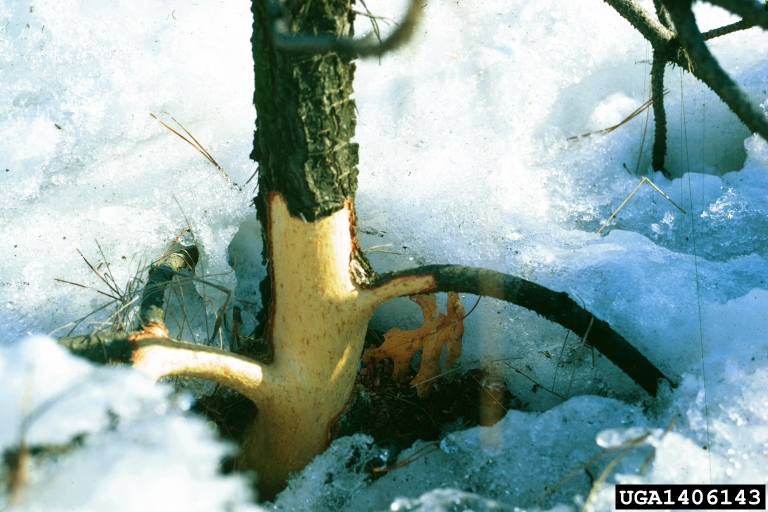Lawn Patrol … Start seeing vole damage

It would be so much easier if wildlife read all the information printed about them, wouldn’t it? But we just can’t fool Mother Nature.
So, when you read that vole damage is particularly bad in years with heavy snows, since that is their cover from predators, I was surprised that in this winterless winter, people are already reporting the telltale trails are appearing in their yards.
But is it voles or is it moles?
Voles: Remember my little trick for remembering the difference between voles and moles-Make a “V” (peace sign for those of you from the ‘60s). V stands for vegetarian and voles. And if you look at the space between the tips of your V fingers, that is about the size of a vole. And V is next to W in the alphabet, reminding me voles are most active in winter.
Voles dine on not only the roots of our turf, hosta crowns and the bark of thin-skinned trees, like fruit trees. Who would think that a little animal the size of a mouse with a little stubby tail, could kill a tree?
Moles on the other hand (you can try to make an “M” with your fingers — you need both hands. M stands for mole and meat eating. No they are not going to Mickey Ds for a Big Mac, but if they had a grub or earthworm McDouble on the menu, then they might. We will leave addressing mole control till their time. But now is the time to talk voles … and control. Well, about that.
First rule of when you notice vole damage and think you have an “infestation” because there are so many runs. Don’t panic. Two little voles can make 20 runs. And not all the runs you see are necessarily active. So, first take a walk to calm down … right over those runs. Press them down with your feet as you walk. Then if they pop back up, you will see where they are currently active. But what happens when none pop back up?
That is why I wanted you to check … voles are primarily active in our lawns in the winter. As soon as the predators show up, they leave for tall grasses and more wild areas. So no treatment if they are not there.
Also, I always ask when I get vole calls, do you live in an open area or a subdivision/neighborhood. No, I am not stalking you, but if you live in an open area, or an area that butts up to a natural area, the idea of “getting rid of them” isn’t reality, as you will have a constant new population replacing the voles you got rid of. But then, you already probably know that. You might have even paid extra for that property.
If you live in a neighborhood/subdivision, and you do have runs pop back up, you can use a snap trap with peanut butter. Just a dot, not a whole sandwich worth. And the best traps seem to be the ones that have one closed end.
There is also a very non-university information recommendation, that has had some anecdotal success. Putting dirty kitty litter down the runs. The “human thinking” is if cats are predators of voles (and if you have ever had a barn/outside cat, you know that is a great way to eliminate voles), then by putting their scent (OK odor) down the runs, then the voles will “think” there is a cat there.
Here is my feeling on this idea: One, what else are you going to do with dirty kitty litter? And if it doesn’t work, OK. No cost, no harm, no foul. Then you go buy a trap.
The other option is, always, do absolutely nothing. Yes, you will have runs, but as soon as Mother Nature turns up the nature thermostat, more sun and more warmth, the grasses we grow as turf are rhizomatous, a fancy way of saying they send out underground runners. And before you know it, most vole runs will disappear by the end of May.
The other problem with voles is they love hosta crowns. When you call me to say there is something wrong with your hostas in April, I first ask if they appear dead or actually missing. If missing, voles came along and ate the crowns over winter. Now you will have to buy new hosta. Nothing is coming back.
There is a fertilizer that has a taste-repellent that many Hosta growers use, and it seems to work successfully against voles and other wildlife. Ingenious really, the plants take up the fertilizer before winter, and along with it, travels the bad tasting repellant. One bite, and they will leave those hostas alone.
The final issue with voles is they find the thin skin of trees and shrubs delectable. Remember, just like how our own human “bark,” aka skin, protects our arteries and veins, the same is true for plants. The life of our plants lies just under the surface of the bark; not buried deep in the heartwood.
So, whether it is a vole munching some bark, or you weedwacking too assertively, tree circulation can be cut off. In November, putting a wire barrier or using tree tape can help protect your woody plants from vole damage.
As far as your overzealous weed-whacking, that is up to you.

Evidence of turf damage from voles (Will County 2023)
